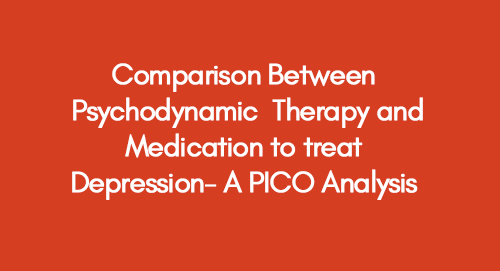
The Impact of Environmental Legacies of Geopolitics on Climate Change of Berlin
June 2, 2022
Interventions of Stress Management in the Aviation Industry; Examining Stress and Burnout Causes and HRM Role
June 2, 2022Introduction
The following research is associated with a detailed PICO analysis in order to determine the efficacy of psychodynamic therapy in comparison to the medications for treating depression.
PICO Research Question
John is a 17 years old male looking for help with his depressive symptoms. He wants to know if psychodynamic therapy would help him overcome depression. The following are the characterized elements of PICO:
- P - 15 to 19 years teenager with depressive symptoms.
- I - Treatment – psychodynamic therapy
- C – Placebo = antidepressants
- O - Reduced depressive symptoms
Question
- How does the use of psychodynamic therapy, in comparison to medication, help treat depression in teenagers?
Rationale
Dash (2018) cites that numerous teenagers in different parts of the world are going through a severe form of depression. The author further highlights that depression can occur owing to diverse reasons, especially in the case of teenagers. The reasons can be obesity, peer problems, academic problems, and even long-term bullying. However, there is not much research available to comprehend if depression in teenagers can be cured by psychodynamic therapy compared to medications. Therefore, a detailed PICO analysis is used to conduct this research. The purpose of carrying out this research is to fulfil the literature gap of understanding to what extent psychodynamic therapies have been useful in treating depression in teenagers instead of using a placebo in the form of antidepressants to treat the condition.
Objectives
The following are the objectives of this study in association with the PICO analysis include:
- To conceptualize the notion of psychodynamic therapy and medication
- To evaluate methods of therapy that are available to treat depression in teenagers
- To assess the use of psychodynamic therapy in comparison to medication help in treating depression in teenagers
- To provide relevant recommendations for the adoption of methods that can be employed to treat depression in teenagers
Study Design
The considered design of the study pertains to the use of two techniques, A Systematic Review method and A Quantitative method which will subsequently follow the PICO analysis. These designs are explained as follows:
Systematic Review Design
A systematic review design pertains to the use of selected articles, reviewing them thoroughly, and analyzing the data obtained from the selected articles (Van Herck et al., 2010). According to the study of Witteman et al. (2016), a systematic review is developed after the analysis and combination of data obtained from both published and unpublished research and then summarising all the results obtained. For this study, the systematic review design will pertain to developing a Prisma framework to elucidate the initial number of selected studies. These studies will help in determining the elements of PICO analysis as mentioned above. After reviewing those studies against inclusion and exclusion criteria, the study was either excluded or included for further review.
Hence for this study, first inclusion and exclusion criteria will be developed, allowing the researcher to select the desired number of articles. A search strategy will also be developed, allowing searching for relevant articles about the field of research. For this study, the search strategy would use keywords such as 'Psychodynamic Therapy', 'Medication', 'Depression in Teenagers', 'Treatment for depression, 'Psychodynamic therapy for depression, and other relevant keywords in search articles. The selected articles will then be analyzed as per their content, and data will be extracted and summarised to meet the objectives of this study.
Quantitative Design
For the implementation of a quantitative design, the researcher will develop a set of survey questionnaires that will be distributed to the concerned participants of this study. The questionnaires would be developed on a 5-point Likert Scale, whereby the respondents will answer the statements as per ‘Strongly Disagree’, ‘Disagree’, ‘Neutral’, ‘Agree’, and ‘Strongly Agree’. The questionnaires would be distributed to a sample size of 80 participants through an online medium. The questionnaires will be circulated to the participants who are working in the healthcare industry, which includes doctors and nurses.
Since this study relates to treating depression in teenagers, the questionnaires would also be distributed to the parents of a teenager whose child is suffering from depression and teenagers who have been cured and no longer have depression. The distributed questionnaire will allow the researcher to measure the effectiveness of different methods employed for the treatment of depression and the difference between the effectiveness of psychotherapy and medication to cure depression. Close-ended questionnaires will be developed for data collection. To analyze the obtained data, the researcher will use the SPSS software to get results and summarise the findings of the results.
Methodology
In research whether or not associated with PICO analysis, the methodology describes the methods adopted to ensure the successful completion of the study with respect to the approach, philosophy, design, and data collection methods. A research methodology allows the researcher to understand the different concepts of the study under researcher and evaluate the concepts based on theories, philosophies, hypotheses, and objectives (Mackey and Gass, 2015). For this study, the following methodology is being considered.
Review the following:
- Dissertation topic and outline writing service
- Dissertation proposal writing service
- Literature review writing service
Research Methodology
The two types of research methodology that are available to a researcher are Qualitative methodology and Quantitative Methodology. By the study by Skinner (2015), qualitative research is employed by researchers to understand the fundamental motives, thoughts, and motivations, and it allows for the providence of insights into issues and aids in the development of ideas and hypotheses for research. On the other hand, according to the study by Haegele and Hodge (2015), researchers use quantitative methods to generate numerical data by quantifying the problem and applying arithmetical formulas to obtain factual data. The quantitative methodology is employed in research because it aids the researchers in quantifying attitudes, sentiments, actions, and other distinct variables and simplifies the outcomes from a bigger sample of people (Antwi and Hamza, 2015).
Research Philosophy
There are three philosophies available that researchers can adopt according to the nature of the study they are conducting. The research philosophies are as follows: Interpretivism, Positivism, and Pragmatism (Thanh and Thanh, 2015). Thanh and Thanh (2015) target the philosophy of interpretivism and explain that it pertains to the observation of real-world phenomena in a qualitative manner. The researcher needs to objectively analyze the phenomena of the real world to find patterns from the observations and make inferences from them. It allows for the integration of human interest in the study the researcher is researching. Furthermore, according to the study of Dudovskiy (2017), the author extricates that researchers who adopt the philosophy of interpretivism assume that they have access to reality only through the development of a social construct such as language, consciousness, shared meanings, and instruments.
According to the study by Campbell (2016), many researchers have acknowledged the fact that the research philosophy of positivism is difficult to explain in a succinct and precise manner. This is because there is a vast amount of difference in the research settings adopted by different researchers. Ray (2017) elucidates that the philosophy of positivism pertains to obtaining factual knowledge that can be gained through the observation of real-world phenomena and enables the researcher to obtain reliable data. The role of researchers who adopt the philosophy of positivism in their studies is related to the collection of data and interpretation of the data in an objective manner (Caldwell, 2015). Additionally, positivism depends on quantifiable observations, leading to statistical analysis. Lastly, in such studies, the researcher is independent, and there are no requirements for human interest.
Research Approach
The researcher in their study can adopt three types of research approaches: inductive, deductive, and abductive. In the study of Liu (2016), the authors explain that an inductive approach or inductive reasoning begins by making real-world observations. Following this, the theories are proposed at the end of the research process, which results from the observations made. Greenfield et al. (2015) extricate that inductive research pertains to the search for patterns from the observations made. It facilitates the development of explanations or theories for the identified patterns through a sequence of propositions.
Furthermore, according to the study by Wheatley (2015), at the beginning of research that employs the use of an inductive approach, no theories or hypotheses are applied, and the researcher is free to shape the direction of the researcher to ensure the research being carried out is of high quality. An important aspect to highlight about research that employs an inductive approach is that this approach does not disregard the use of theories when formulating objectives and research questions (Hamilton, W., Ying and Leskovec, 2017). The study of Grinchenko and Shchapova (2020) extricates that researchers that employ a deductive approach are concerned with developing a hypothesis based on an existing theory and then tend to work on developing a research strategy that tests the hypothesis to be true or false.
Zalaghi and Khazaei (2016) describe that a deductive approach means studying a particular aspect of the real world and then generalizing the results. For example, if a causal relationship between one or more variables can be implied with a theory or a case example, a deductive approach would test the relationship between these variables to acquire information on prevailing circumstances. According to the study by Spector and Pindek (2016), the development of a hypothesis in research aid the explanation of a deductive approach being adopted that can be consequential from the proposals of the theory. In simpler terms, the deductive approach is concerned with construing assumptions from premises or suggestions.
Data collection
In the study by Katz (2015), the author describes the qualitative method as a research method focused on obtaining data through quality means, such as interviews or open-ended questionnaires. Researchers who employ the use this method in their research are inclined toward not only finding out “What” people think about a certain phenomenon but also explores on the question of “Why do people think like that (Glesne, 2016). Silverman (2016) describes the data collection methods associated with qualitative research, most commonly employed by researchers, including unstructured or semi-structured techniques, such as interviews.
These data collection methods allow the researcher to discover trends in opinions and views and dive deeper into the issue. Contrarily, Hartas (2015) describes quantitative research as a methodical examination of phenomena by the congregation of quantifiable data and the execution of mathematical methods to gain realistic data based on evidence. The data collection methods employed for quantifiable data pertain to using or sending out online surveys, polls, questionnaires, etc. The results obtained from these data collection methods can be reconstructed into computable data (McCusker and Gunaydin, 2015).
Drop us a message on Whatsapp or by Email if you want to access the complete report of the above article. We will get back to you within 24 hours.
References
Antwi, S.K. and Hamza, K., 2015. Qualitative and quantitative research paradigms in business
research: A philosophical reflection. European journal of business and management,
7(3), pp.217-225.
Bell, E., Bryman, A. and Harley, B., 2018. Business research methods. Oxford university press.
Bernard, H.R., 2017. Research methods in anthropology: Qualitative and quantitative
approaches. Rowman & Littlefield.
Brownson, R.C., Colditz, G.A. and Proctor, E.K. eds., 2017. Dissemination and implementation
research in health: translating science to practice. Oxford University Press.
Caldwell, B., 2015. Beyond positivism. Routledge.
Campbell, T.D., 2016. The legal theory of ethical positivism. Routledge.
Dash, S., 2018. Young adults with depression—are we paying attention?—a review on
depression in teenagers in the 21st Century. Life Research, 1(2), pp.32-39.
Dudovskiy, J., 2017. Interpretivism (interpretivist) research philosophy. Research Methodology.
Glesne, C., 2016. Becoming qualitative researchers: An introduction. Pearson. One Lake Street,
Upper Saddle River, New Jersey 07458.
Green, C.A., Duan, N., Gibbons, R.D., Hoagwood, K.E., Palinkas, L.A. and Wisdom, J.P., 2015.
Approaches to mixed methods dissemination and implementation research: methods,
strengths, caveats, and opportunities. Administration and Policy in Mental Health and
Mental Health Services Research, 42(5), pp.508-523.
Greenfield, B., Bridges, P., Phillips, T., Adams, E., Bullock, D., Davis, K., Nelson, C. and
Wood, B., 2015. Reflective narratives by physical therapist students on their early clinical experiences: A deductive and inductive approach. Journal of Physical Therapy
Education, 29(2), pp.21-31.
Grinchenko, S. and Shchapova, Y.L., 2020. The deductive approach to Big History’s Singularity.
In The 21st Century Singularity and Global Futures (pp. 201-210). Springer, Cham.
Haegele, J.A. and Hodge, S.R., 2015. Quantitative methodology: A guide for emerging physical
education and adapted physical education researchers. The Physical Educator, 72(5).
Hamilton, W., Ying, Z. and Leskovec, J., 2017. Inductive representation learning on large
graphs. In Advances in neural information processing systems (pp. 1024-1034).
Hartas, D. ed., 2015. Educational research and inquiry: Qualitative and quantitative
approaches. Bloomsbury Publishing.
Katz, J., 2015. A theory of qualitative methodology: The social system of analytic fieldwork.
Méthod (e) s: African Review of Social Sciences Methodology, 1(1-2), pp.131-146.
Liebenberg, L., 2017. Editor’s Introduction: Special Issue: Understanding Meaningful
Engagement of Youth in Research and Dissemination of Findings. International Journal
of Qualitative Methods, 16(1), p.1609406917721531.
Liu, L., 2016. Using Generic Inductive Approach in Qualitative Educational Study Analysis. Journal of Education and Learning, 5(2), pp.129-135.
Mackey, A. and Gass, S.M., 2015. Second language research: Methodology and design.
Routledge.
McCusker, K. and Gunaydin, S., 2015. Research using qualitative, quantitative or mixed
methods and choice based on the research. Perfusion, 30(7), pp.537-542.
Neta, G., Glasgow, R.E., Carpenter, C.R., Grimshaw, J.M., Rabin, B.A., Fernandez, M.E. and
Brownson, R.C., 2015. A framework for enhancing the value of research for
dissemination and implementation. American Journal of Public Health, 105(1), pp.49-57.
Quinlan, C., Babin, B., Carr, J. and Griffin, M., 2019. Business research methods. South Western
Cengage.
Ray, C., 2017. Logical positivism. A companion to the philosophy of science, pp.243-251.
Silverman, D. ed., 2016. Qualitative research. Sage.
Skinner, D., 2015. Qualitative methodology: an introduction.
Spector, P.E. and Pindek, S., 2016. The future of research methods in work and occupational
health psychology. Applied Psychology, 65(2), pp.412-431.
Thanh, N.C. and Thanh, T.T., 2015. The interconnection between interpretivist paradigm and
qualitative methods in education. American Journal of Educational Science, 1(2), pp.24-
27.
Van Herck, P., De Smedt, D., Annemans, L., Remmen, R., Rosenthal, M.B. and Sermeus, W.,
2010. Systematic review: effects, design choices, and context of pay-for-performance in
health care. BMC health services research, 10(1), p.247.
Wheatley, J., 2015. Identifying latent policy dimensions from public opinion data: An inductive
approach. Journal of Elections, Public Opinion & Parties, 25(2), pp.215-233.
Witteman, H.O., Scherer, L.D., Gavaruzzi, T., Pieterse, A.H., Fuhrel-Forbis, A., Chipenda
Dansokho, S., Exe, N., Kahn, V.C., Feldman-Stewart, D., Col, N.F. and Turgeon, A.F.,
2016. Design features of explicit values clarification methods: a systematic review.
Medical Decision Making, 36(4), pp.453-471.
Zalaghi, H. and Khazaei, M., 2016. The role of deductive and inductive reasoning in accounting
research and standard setting. Asian Journal of Finance & Accounting, 8(1), pp.23-37.
Get 3+ Free Dissertation Topics within 24 hours?


























